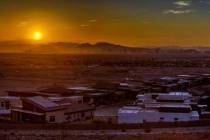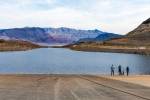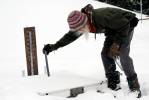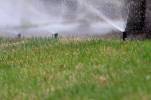Nevada’s fish weather third summer of drought
RENO — Northern Nevada’s fish were certainly affected but on the whole appear to have weathered a third summer of drought without any serious crash in population.
While some die-offs occurred, trout in the region’s rivers and streams, lakes and reservoirs made it to the fall season in relatively good shape, biologists report. With temperatures now cooling and some precipitation likely on the way before long, the danger appears past.
“It’s good news. At the beginning of the season I really did fear the worst,” said Kim Tisdale, supervisory fisheries biologist for the Nevada Department of Wildlife. “We actually were able to pretty much dodge the bullet this summer.”
Three dry winters in a row have lowered water levels across Northern Nevada and the Sierra Nevada. The result is a challenging aquatic environment for trout and other fish. In rivers, fish are crowded into shrinking pools of water where smaller fish — pushed clear of habitat where they can hide — become vulnerable to predation by larger fish.
“All of our rivers are very low,” Tisdale said. “The fish are all squeezed together.”
Perhaps the biggest danger lay with the possibility that temperatures in shallow waters of places like the Truckee River could rise in summertime heat to the point they no longer are able to hold adequate dissolved oxygen to support fish survival. That’s what can cause massive die-offs with the possibility of wiping out entire fisheries.
Fish kills did occur at Topaz Lake in southern Douglas County and at Squaw Creek Reservoir north of Gerlach. At Onion Valley Reservoir in the Pine Forest Range of Humboldt County, drought and irrigation demands lowered water levels to the point that trout fishery was lost, Tisdale said.
Sufficient water remained in the diminished Lahontan and Rye Patch reservoirs for fish — bass, walleye, crappie and catfish among them — to survive there.
At the Truckee River, things could have worked out far worse.
“It was pretty close. If we had a few more weeks of hot weather, we could have seen some fish kills, especially in the lower river,” Tisdale said. Most fish also apparently made it through the summer in the Carson and East Walker rivers.
An unusual string of wet monsoonal weather in August was a big help in getting through the summer overall.
“Those summer storms helped postpone the inevitable. We had longer than we would have otherwise,” Tisdale said.
In an irony of sorts, lowered water levels will prevent Tisdale and colleagues from getting an adequate reading on just how much the drought did affect those fish in the Truckee River. Each fall, biologists use electrofishing gear to shock the river’s fish to help determine population, distribution and other characteristics of fish in the river that year.
This fall, there’s too little water left flowing in the river to float the barge used for the fish survey. Some limited work using gear mounted on backpacks might still be possible.
“We’re going to need a good winter to catch us up,” Tisdale said of the months ahead.




























